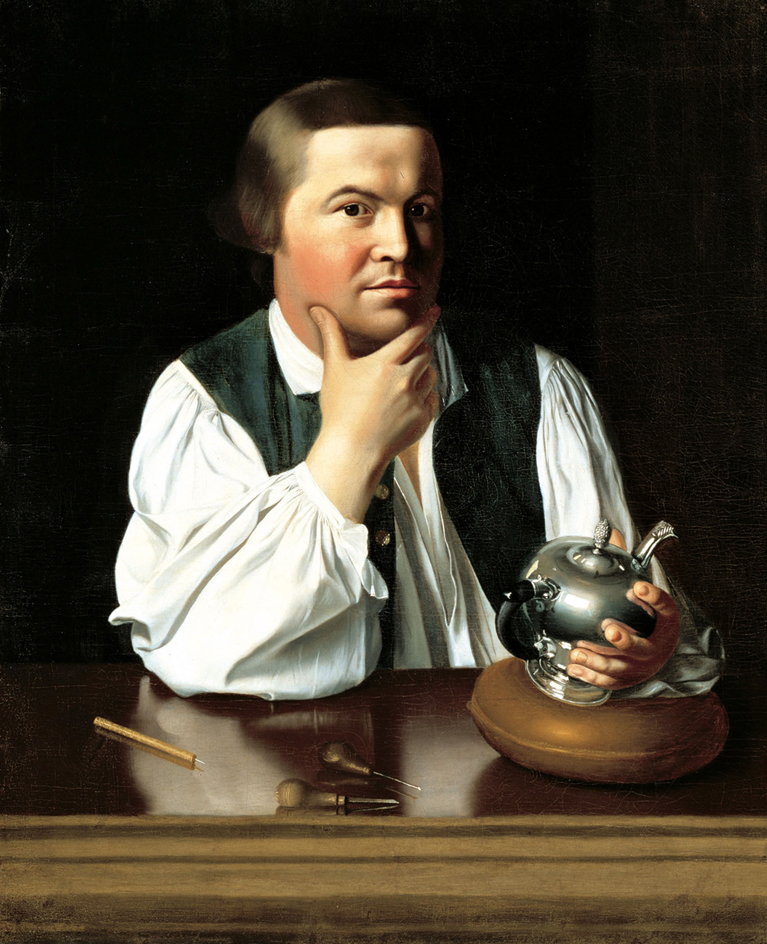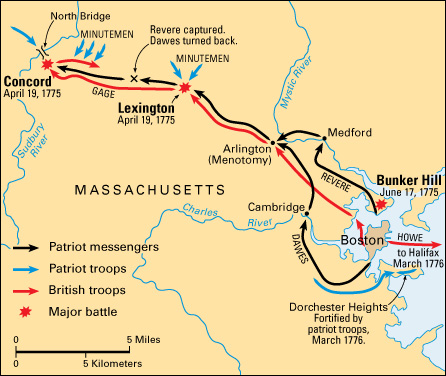Revere, Paul (1734-1818), an American craftsman and patriot, became famous for his contributions during the American Revolution (1775-1783). In April 1775, he rode on horseback from Boston to Lexington, Massachusetts, carrying news of the approach of the British. He warned the patriot leaders Samuel Adams and John Hancock of their danger and called the citizens of the countryside to arms. His exploit inspired Henry Wadsworth Longfellow’s “Paul Revere’s Ride” (1861), one of the most popular poems in American literature. Revere made other contributions during the American Revolution and aided the industrial growth of the United States.

His early life.
Paul Revere was born in Boston. No official records exist of his birth, only of his baptism. It is believed he was born in December 1734. He was baptized on Jan. 1, 1735 (Dec. 22, 1734, on the Old Style Calendar then in use; see Calendar ).
Revere was the son of a silversmith. His family was of French Protestant, or Huguenot, descent. His father changed the family name from Rivoire “merely on account that the Bumpkins should pronounce it easier.” Paul studied at North Writing School in Boston and learned the silversmith’s trade. In 1756, he served briefly in the French and Indian War. Then he married Sarah Orne and took over his father’s silversmith business.
The patriot.
Revere soon became interested in supporting American liberty. He engraved a number of political cartoons that received wide attention. As the leader of the Boston craftsmen, he worked closely with such revolutionary leaders as Samuel Adams and John Hancock. Revere took part in the Boston Tea Party on Dec. 16, 1773. Revere also served as a special messenger for the Boston patriots. He was so familiar to the British in this role that his name appeared in London journals before his famous ride. Two days before the ride took place, he galloped to Concord to warn patriots there to move their military supplies.
Paul Revere’s ride.
In 1775, King George III instructed General Thomas Gage, the British commander in chief in Massachusetts, to enforce order among the rebellious colonists. Gage ordered Lieutenant Colonel Francis Smith to Concord with a detachment of 700 men. Smith and his soldiers were to destroy the supplies there and to arrest Adams and Hancock for treason.
Smith assembled his force on Boston Common on the evening of April 18. His orders were secret, but the patriots knew about them. Patriot leader Joseph Warren sent Revere and William Dawes by separate routes to warn Adams and Hancock in Lexington and the patriots in Concord. Revere arranged for a signal to be flashed from the steeple of Boston’s Old North Church. Two lanterns would mean the British were coming by water, and one, by land. Contrary to Longfellow’s account, the signal was not sent to Revere. Instead, Revere directed that the signal be sent to friends in Charlestown.
Revere left Boston at about 10 p.m. and arrived in Lexington about midnight, riding a borrowed horse. Shortly after 1 a.m., Revere, William Dawes, and Samuel Prescott left for Concord. A British patrol surprised them on their way. Prescott and Dawes escaped, but Revere was captured. Only Prescott got through to Concord. The British released Revere and let him return to Lexington without his horse. There, he joined Adams and Hancock. The men fled to safety in Burlington, but Revere returned to Lexington to rescue valuable papers in Hancock’s trunk. When the British arrived in Lexington on April 19, they found the minutemen waiting.

Revolutionary soldier.
From 1776 to 1779, Revere commanded a garrison at Castle William in Boston Harbor. In 1779, he commanded artillery in the disastrous Penobscot Expedition, an attempt to regain control of British-held territory in Maine. The expedition cost Massachusetts much of its trading fleet. Revere was accused of cowardice and insubordination, but a court-martial cleared him of wrongdoing in 1782.
Craftsman and industrialist.
When the war started, Revere visited a gunpowder mill near Philadelphia. He then supplied plans, based on this visit, for a gunpowder mill at Canton, Massachusetts. Historians believe he probably oversaw the mill’s construction. He also engraved and printed paper currency for Massachusetts, and he made the state seal still used by Massachusetts.
During and after the war, Revere continued his silversmith trade in Boston. Craftworkers still copy the graceful lines of his work. He marked his own work with the name Revere in a rectangle or with the initials P.R. He cast cannon and bells in bronze, and many of his bells are still used in New England. He made the copper fittings for the frigate U.S.S. Constitution (“Old Ironsides”).
Revere was the first American to discover the process of rolling sheet copper, and he built the first successful copper-rolling mill in the United States. Revere died on May 10, 1818.
